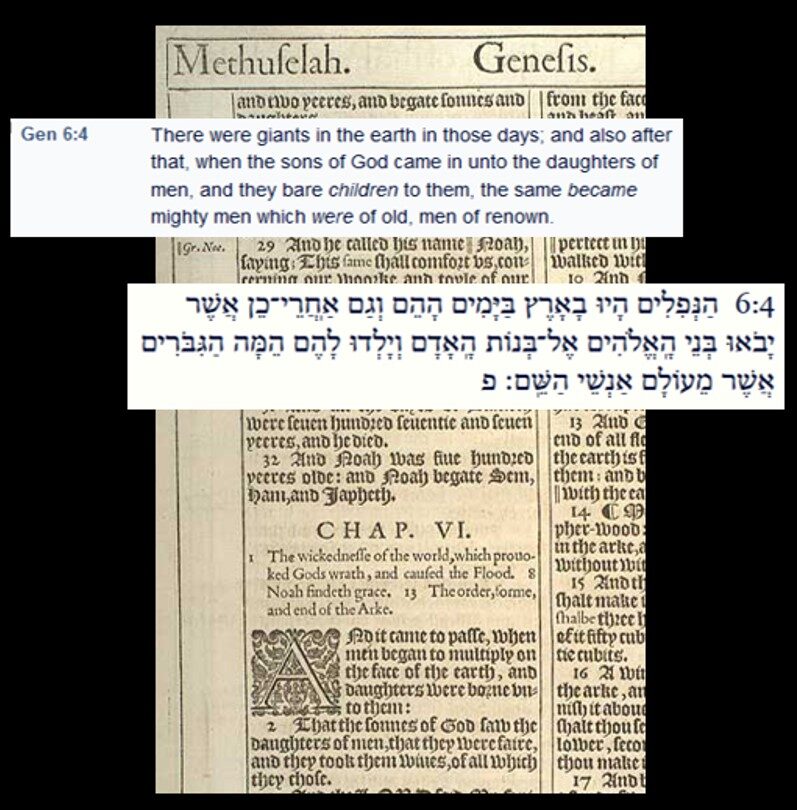In view is Robert C. Newman’s article “The Ancient Exegesis of Genesis 6:2, 4,” Grace Theological Journal, 5, 1 (1984 AD), pp. 13-36.
Newman notes that the “interpretation of ‘sons of God’ as angels and ‘Nephilim’ as giants dominates” the ancient interpretations and is thus the older view of both Jewish and Christian commentators. He surveyed “the ancient interpretation of Gen 6:2, 4 in Jewish literature, in Christian literature and in the NT in particular:
The earliest extant view is the supernatural one, that the “sons of God” were angels…The sin in this case was the unnatural union between angels and humans…The nonsupernatural interpretations are not extant until later…

The Septuagint aka LXX “was probably produced in the middle of the 3rd century B.C.” for which Newman cites “Extant MSS of Genesis” which:
…render [Hebrew for sons of God] variously as [Greek for sons of God] and [Greek for Angels of God]…The variant [Greek for Angel] is the minority reading among extant MSS and versions, but it is supported by many witnesses, including Codex Alexandrinus (4th century A.D.), as well as Philo and Josephus, both writing in the 1st century A.D. though extant only in much later MSS. These latter comment on the passage in such a way that their reading cannot be dismissed as a scribal error from later Christian copyists. [Greek for sons] is the majority reading, for which the most important witnesses are papyrus 911 (3rd century A.D.) and Codex Coislinianus (7th century). The Gottingen LXX favors the latter reading since it is supported by all the MS groups, though none are as early as Philo and Josephus. Yet the influence of the MT [Masoretic Text] on the transmission of the LXX might well explain [Greek for sons], even if [Greek for Angel] were the original translation.
It is therefore impossible to be certain whether [Greek for Angel] was the original translation or an early midrashic [homiletic interpretation] corruption.
Robert Newman notes that the sons of God versus Angels of God “variant is already cited and discussed by Philo [in On the Giants 6, see my Philo of Alexandria on the Nephilim.], so apparently predates the 1st century A.D.”
He also notes that “In Gen 6:4 [Hebrew for Nephilim] is translated [Greek for giants]; without textual variation. The Greek word, usually rendered ‘giant,’ indicates a warrior of large stature and translates [Hebrew spelling of gibbor: generally “mighty” in English trans.] in Gen 10:8, 9.”
Aquila’s Greek Old Testament dating to circa 130 AD has sons of God, “which looks more like an attempt to avoid the problem of the one true God having sons than it does a preference for either of the interpretations we are considering…‘those who fall upon,’ which might be either supernatural ‘those who fall upon (earth)’ or nonsupernatural ‘those who attack.’” Symmachus’ Greek Old Testament dating to late in the 100s AD employs terms “meaning either ‘sons of the powerful’ or ‘sons of the rulers,’ rather like the targumic views…‘violent ones.’”
Theodotion (died circa 200 AD) “of whom little is known” also produced a Greek Old Testament which reads a normative Genesis 6.
The “Babylonian Talmud…6th century A.D….Yoma 67b refers to the scapegoat being called Azazel because it atones for the ‘affair of Uza and Aza’el,’ probably a reference to the Shamhazai and Azael of 1 Enoch and Tg. PS.-J. Nid. 61a speaks of an Ahijah, son of Shamhazai”:
Our Rabbis taught: Azazel — it should be hard and rough [“Az and el mean strong, irresistible, impudent”]. One might have assumed that it is to be in inhabited land, therefore the text reads: “In the wilderness”. But whence do we know that it [is to be in] a Zok? [“Zok means a mountain peak; it may be the special name of the mountain whence the he-goat was flung down”] —
Therefore the text reads: “Cut off’. Another [Baraitha] taught: Azazel, i.e., the hardest of mountains, thus also does it say: And the mighty of the land he took away. The School of R. Ishmael taught: Azazel — [it was so called] because it obtains atonement for the affair of Uza and Aza’el [“This is a reference to the legend of fallen angels, based partly on Gen. VI, 4 and also on foreign lore. V. Jung, L. “Fallen Angels in Jewish, Christian and Mohammedan literature’” see my Apocryphal Texts on Paranormal Entities and Islam’s magickian fallen angels Harut and Marut].
~~~~~~~~~~~~~~~~~~~~~~~~
A plea: I have to pay for server usage and have made all content on this website free and always will. I support my family on one income and do research, writing, videos, etc. as a hobby. If you can even spare $1.00 as a donation, please do so: it may not seem like much but if each person reading this would do so, even every now and then, it would add up and really, really help out. Here is my donate/paypal page.
Due to robo-spaming, I had to close the comment sections. However, you can comment on my Twitter page, on my Facebook page and/or on my Google+ page.
